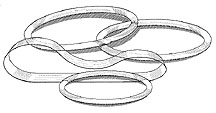Pyramid's Quality Assurance Inspection Procedures
There are two tests performed on every line item of every order prior to shipment. The quantity of items checked from each line depends on the total line quantity. These tests are the tensile strength test and quality assurance (QA) check.
Quality Assurance (QA) Checks

Quality assurance tests are non-destructive tests of the belt’s or extrudate’s dimensions and material compared to the specifications on the order. Round belts are measured for cross-section and length while flat belts are measured for thickness, width and length. For all cross-section or thickness and width readings, tests are performed on opposite sides of the belt to get an average reading for the entire belt. Length is calculated using a diametape, a flexible ruler which is coiled inside the belt circumference and provides either the inside circumference of the belt or inside diameter, which is then converted to belt length. Belts over 62” cannot be measured by our diametapes, but are measured using a measuring tape. These results are also fed into our database for further examination and analysis.
All of the instruments used for measuring the belts are traceable to NIST standards. The diametape and measuring tape are listed on our normal calibration schedule and the hand calipers used to measure cross section or thickness and width are calibrated every morning using an NIST standard plug gage.
A result of Pass or Fail is achieved for cross-section and length on round belts and for thickness, width and length on flat belts. A visual and tactile check assures that the belt is made from the correct material and any other special requirements are met (color, texture, etc.). Any belt that falls outside of our tolerance on any of the dimensions or that is made from the wrong material fails the check. An additional belt is tested to determine if the failure was a fluke or a problem with the order. Any failure must be reported to a supervisor and logged in the Internal Issues Log if it causes a job to be remade.
Once all items on an order have been tested and passed inspection, an inspection label is placed on the box containing the order.
Previous Page--Tensile Strength Tests
Next Page--Non-Conforming Material Disposition













